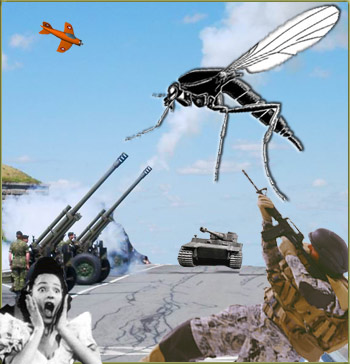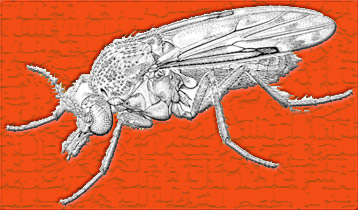|

Noseeums are easy to kill…
| Noseeums, biting midges, insects from beyond the lower inferno…whatever you want to call them, are easy enough to kill. Just smash them with your finger. This is great, if you see one. The problem is that even if you see one, you may not see it. They are that small. Some people claim they can feel them crawling around. I certainly can’t…and that’s even when I have all my receptors turned up to max.
Noseeums live in the top part of the forest soils in the leaves. They prefer damp places, but it’s not mandatory with them. While chiggers and ticks in our area seem to go dormant about the first of October, noseeums may not until much later, or maybe not at all. I suspect they are ready for a good feed on any warm day, of which there are plenty right thru the middle part of December.
The current thinking is that noseeums will generally travel not more than 300 feet from the hatching place. I guess there are any number of them on the wing anyway, but you really stir them up as you scruffle along in the leaves scouting, hunting, or just walking around in your back yard. To a noseeum, your open pant leg looks like just about the most inviting place in the whole world. Once they fly up that warm, yawning cave, it’s tux, tie and tails all the way for a super dining experience. You can tie down your pants leg and zip up everything else real tight, but it really doesn’t matter to something as small as this hellishly hungry creature.
The good news is that they hate insect repellants with DEET as much as mosquitoes. The bad news is that if you’re a deer hunter, deer don’t think much of it either. So, bug repellant does work, so it is said. It’s all about how much you hate noseeums and love to eat venison. If you are a backpacker, you might consider one of a number of head to toe mesh outfits you can purchase. It’s cheaper than a surplus NASA space suit. The best of all defense seems to be wide expanses of dry, leafless terrain…like grass filled subdivisions. It says something for living in town.
I have spoken in particular to outdoorsmen, because they are…mostly outdoors. Frankly, I don’t have any experience with home owners who are faced with a noseeum problem. I really can’t imagine. I really can’t. While noseeums will die just as well as most other bugs if enough poison is used, they are so numerous as to make them almost impossible to control. And we are talking control…not eradication. Like our friends, kudzu and fire ants, it looks like they are here to stay.
So, friends. The tip off that you have made the acquaintance of Ms. Ceratopogonidae, AKA, devil insect- fly from the bad place, is that about a day later, a small intensely itchy bump will rise from your soft flesh. Later, it may develop a clear blister. Scratching and digging at the bump, as you will doubtless do, only make it worse. The itching, along with the bump, will fade after a week or so. Since you will have a lot of bumps to deal with, you’ll have even more respect for the stealthy little biting fly that inflicts so much itchiness out of all proportion to its size. You will marvel at the loathing and fear that something you can barely see, if you see it, will generate in your human psyche. Hey…I respect the noseeum. Big time!
Below are some interesting and useful facts that aren’t in dispute….
- The noseeum is actually a fly. There are 136 known families of flies and the noseeum belongs to the family Ceratopogonidae.
- The noseeum is also known as a biting midge. British folks call them punkies. They are seen worldwide, mostly in warmer climates. They don’t suck….they bite. Actually, they chew up a little place on your skin and, much as the mosquito regurgitate a little spit to keep everything flowing while they dine.
- They range from 1/4 to 1/32 inch long. We seem to have the smaller variety. They are so small that the only way you can see them at a distance is thru the filtered forest sunlight. They look like little specks of pocket lint floating in the sun rays. They are so small that cleaned, baked, and served with all the trimmings, it would take 2 to fill up the tummy of a gnat for his Sunday lunch after church. They are so ridiculously tiny that they can fly right thru a screen door.
- Elsewhere, noseeums serve a beneficial purpose. Again, like the mosquito, only the female is a blood drinker. The male contents himself with flower nectars. In Costa Rica, they serve as pollinators of the rubber tree. As primary pollinators, they also take care of business in respect to the cacao bush too. So, in other words, without them, you would have no way to drive to the candy store to purchase chocolate which comes from cacao. Same for mangos. Most southerners could do without mangos, but chocolate is a different matter.
- In our area, much like fire ants and kudzu, noseeums probably serve no good purpose, or at least one that could be done just as well by something else. We were getting along just fine before these things arrived, thank you very much!
- Some species of noseeums are not very nice. In South America, at least one type carries life threatening diseases. In Alabama some carry infections that can kill deer and cattle, including hemorrhagic diseases, which can turn an animal’s innards into a soupy bloody mess. Sort of the Ebola of the animal world. To date, at least, man is safe from our local invaders in this respect. For cattle and deer, the scientific description of the diseases are …. Epizootic Hemorrhagic Disease (EHD) and bluetongue (BT) viruses for white-tailed deer.
|
|
|
|
Noseeums…
Devil Insect From The Bad Place
There is a whole lot of itching going on out there, and the wrong insects are being blamed for it. Ready yourself for equal parts of conjecture and fact regarding our newest woodland friends, noseeums.
Most outdoorsmen, ladies, and children are aware of the perils of chiggers, ticks, and mosquitoes on forays into the wilderness, but few know of the family Ceratopogonidae. I believe they didn’t exist here in and around Calhoun County, Alabama until 20 years or so ago. All I have is anecdotal evidence…I never got bit by one before then.
I can remember my first experience in the Choccolocco Wildlife Management area in Cleburne county. While exploring the forest wilds of the region known only as “12 Deer” on my personal map, I happened across a strange little spit of sand in a wet weather spring. It is here, while looking for animal tracks that I think I first encountered noseeums. Someone back then confidently told me that I had ran afoul of something called sand fleas.
Can you say Ceratopogonidae?
Some years later, much to my consternation, they found me again about a mile away at a shooting range. Then, later still, miles away, way up in a mountain lake, I was swarmed. The common fact was that prior to 20 years or so ago, I had never been host to the devilish creatures.
It may be of some interest to learn that other noxious species of flora and fauna have found their way to our area, where before, they weren’t. Case in point is the fire ant. It is known that the black fire ant first landed in Mobile in 1918, followed a couple of years later by the red fire ant. Both types of ant are native to south America, and most likely were deposited on our shore by unloading boats from across the big waters.
Kudzu, the delightful green vine we’re so familiar with, arrived in America in 1876, a present from the Japanese. It wasn’t until the 1940’s that it was used in the area as a popular ground cover and animal feed.
So, armed with these facts, until someone tells me differently, I believe our noseeum invasion is of fairly late origin. For all my study on the subject, I can find nothing to disabuse me of the notion. It probably came here in a flower pot from down south. There is a not inconsiderable amount study going on as regards noseeums. More than you would expect, actually. There is much flyings, seminaring, and spendings of your tax money by highly educated college professors. Unfortunately, they don’t tend to publish much, and much of what they publish is about as practical, useful and interesting as articles about sleet storms on the planet Uranus. Also, even though worldwide, noseeums are a tremendous problem, what is known is mostly generality, and even in this there are good natured high brow conflicts.
Reprinted here courtesy: GetCalhoun.com
The Internet Voice of Calhoun County, Alabama
Let’s get real here. There are more than 5000 identified noseeum species, and this is admittedly only a fraction of what exists.
******
Not enough blood and guts for you? Would you like to study up on the other bane of the woodsman’s existence, the lovable chigger? Click the chigger box on the left for the latest Alabama Chigger news!
|
The absolute bane of human existence where they thrive, the Noseeum is little known in Calhoun County, Alabama. To know them is to not love them.
Many excellent lab quality specimens have been found in 120 million
year old fossilized amber… So this proves they are not the byproduct of unwise atomic testing.
Below is what scientists call a “Chigger Box”
Click it for the latest chigger news…

|
|

